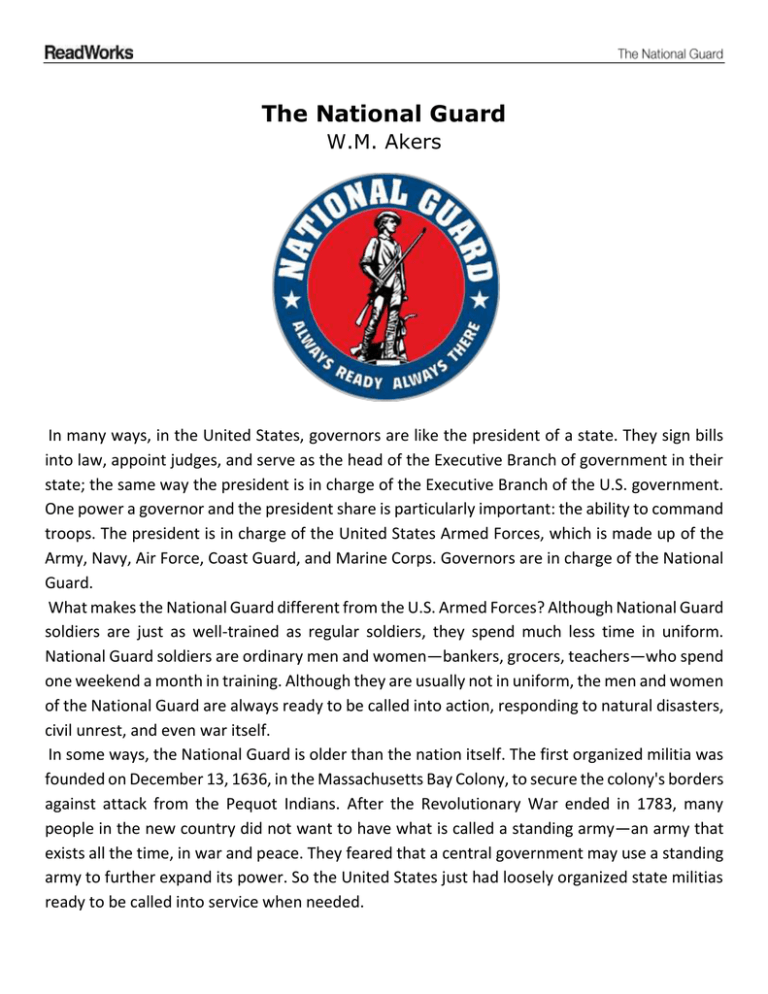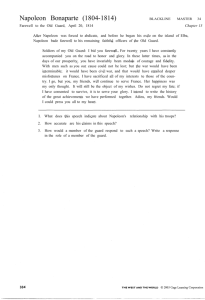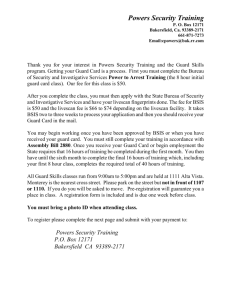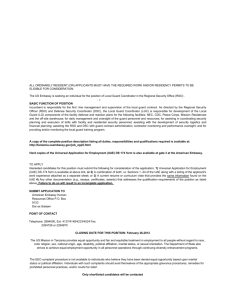
The National Guard
W.M. Akers
In many ways, in the United States, governors are like the president of a state. They sign bills
into law, appoint judges, and serve as the head of the Executive Branch of government in their
state; the same way the president is in charge of the Executive Branch of the U.S. government.
One power a governor and the president share is particularly important: the ability to command
troops. The president is in charge of the United States Armed Forces, which is made up of the
Army, Navy, Air Force, Coast Guard, and Marine Corps. Governors are in charge of the National
Guard.
What makes the National Guard different from the U.S. Armed Forces? Although National Guard
soldiers are just as well-trained as regular soldiers, they spend much less time in uniform.
National Guard soldiers are ordinary men and women—bankers, grocers, teachers—who spend
one weekend a month in training. Although they are usually not in uniform, the men and women
of the National Guard are always ready to be called into action, responding to natural disasters,
civil unrest, and even war itself.
In some ways, the National Guard is older than the nation itself. The first organized militia was
founded on December 13, 1636, in the Massachusetts Bay Colony, to secure the colony's borders
against attack from the Pequot Indians. After the Revolutionary War ended in 1783, many
people in the new country did not want to have what is called a standing army—an army that
exists all the time, in war and peace. They feared that a central government may use a standing
army to further expand its power. So the United States just had loosely organized state militias
ready to be called into service when needed.
© 2014 ReadWorks®, Inc. All rights reserved.
In the several years to follow, there were a number of challenges that brought to light the
ineffectiveness of the weak federal government, especially in times when the safety of the
country’s people was threatened. In 1789, the United States Congress adopted the Constitution,
which strengthened the federal government. A few weeks later, Congress legalized a standing
army, the United States Military. However, states were still allowed to have militias. Toward the
end of the Whiskey Rebellion that started in 1791 and ended in 1794, George Washington used
state militias to end the protest over taxation.
It took several laws to transform those state militias into the well-organized National Guard we
have today. The 1903 Militia Act arranged for federal funding for state militias. The National
Defense Act of 1916 explained how and why the National Guard could be called into action. The
National Guard is most commonly deployed after a natural disaster, like a hurricane or
earthquake. In 1927, the Great Mississippi Flood covered an area the size of New England with
water. One thousand people were killed and more than 700,000 were forced out of their homes.
Mississippi governor John E. Martineau called up the National Guard to help deal with the crisis.
This marked the first time National Guard aircraft were used after a major natural disaster. Flying
small planes, 60 National Guard pilots scoured the flooded area looking for survivors and
distributing food, medicine, and supplies.
Eighty years later, the National Guard's duties are largely the same. After Hurricane Katrina
devastated New Orleans, the National Guard was there. Soldiers and airmen from all 50 states
were deployed to Louisiana to help people the same way they did after the Great Flood of 1927.
Over 50,000 National Guardsmen were involved in the recovery efforts.
While those National Guardsmen were fighting the flood in Louisiana, other members of the
National Guard were overseas involved in a different kind of battle. Even though they are not
regular soldiers, the National Guard can be called up during times of war. National Guard units
have served in every major American conflict, from the Civil War right up until today. During
wartime, the Guard is no longer under a governor's control, but is instead commanded by the
president. Calling in the National Guard can be the most important decision a governor ever
makes. It may be as a response to a natural disaster affecting the state. Other times may include
a response to a terrorist attack in the state or a riot that can no longer be contained by the local
police. Whenever unrest threatens an American city, the National Guard is available to restore
order and protect the home front. They may only train for one weekend each month, but the
men and women of the National Guard are soldiers all the same.
© 2014 ReadWorks®, Inc. All rights reserved.
Questions: The National Guard
Name:
Date:
1. What makes the National Guard different from the Army, Navy, Air Force, and
Marines?
A
B
C
D
They
They
They
They
can assist in times of war.
can be called upon by the president of the United States.
spend much less time in uniform.
are prepared to help with natural disasters.
2. What does the author describe?
A
B
C
D
the history of the American Armed Forces
examples of when the National Guard has been used
the training National Guard soldiers receive
how the National Guard is organized during times of war
3. The men and women of the National Guard are well trained. What evidence from the
passage best supports this conclusion?
A National Guardsmen can be sent overseas during times of war.
B During wartime, the National Guard is under the president’s command.
C The National Defense Act describes when the National Guard can be called
upon. D The National Guard is made up of ordinary men and women.
4. The National Guard has always played an important role in America. What evidence
from the text best supports this conclusion?
A
B
C
D
The first organized militia was founded on December 13, 1636.
National Guard units have served in every major American conflict.
Calling in the National Guard is an important decision for a governor.
The great Mississippi River Flood was the first time National Guard aircrafts
were used.
5. What is this passage mainly about?
A the difference between the National Guard and the national Armed Forces
B the history of the National Guard
1
© 2014 ReadWorks®, Inc. All rights reserved.
Questions: The National Guard
C the importance of the National Guard to America’s safety and security
D the duties of governors in their states
6. Read the following sentence: “Flying small planes, 60 National Guard pilots scoured
the flooded area looking for survivors and distributing food, medicine, and supplies.”
What does the word “scoured” most nearly mean?
A
B
C
D
searched
set on fire
left
cleaned
7. Choose the answer that best completes the sentence below.
When the Revolutionary War ended, the country created loosely organized militias that
could be called upon in times of need, _______ The Whiskey Rebellion of 1791.
A
B
C
D
above all
at last
consequently
such as
8. In the passage, the author states that the National Guard is often called upon after
natural disasters. What evidence from the text supports this conclusion?
______________________________________________________________________
______________________________________________________________________
______________________________________________________________________
______________________________________________________________________
2
© 2014 ReadWorks®, Inc. All rights reserved.
Questions: The National Guard
9. Read the following sentence from the passage: “They may only train for one weekend
each month, but the men and women of the National Guard are soldiers all the
same.” Use evidence from the text to support this statement.
______________________________________________________________________
______________________________________________________________________
______________________________________________________________________
______________________________________________________________________
10. Explain how the history of the National Guard shows that the National Guard is an
important part of America’s government. Use information from the passage to
support your answer.
______________________________________________________________________
______________________________________________________________________
______________________________________________________________________
______________________________________________________________________
3
© 2014 ReadWorks®, Inc. All rights reserved.





